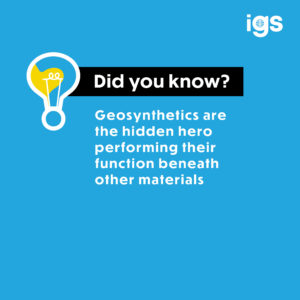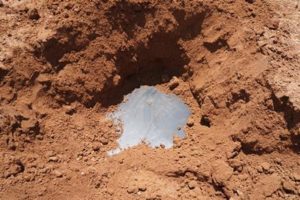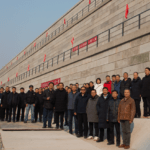
It is well known geosynthetic materials make positive contributions to sustainable infrastructure and a clean and healthy environment. What is less known is that the vast majority of them do their work beneath ground level, covered over with soil, sand, concrete and other materials after installation.
This applies to a range of applications, from roads, landfill and mining, to water containment, canals, erosion control, filtration and soil strengthening and separation. Let’s take a closer look…
- In paved and unpaved roadways, geotextiles and other materials are used as a separating layer or to improve soil performance and capabilities. In these cases, the geosynthetics are covered with asphalt, concrete, or on-site soils.
- In landfills and mining, barrier and drainage, layers of geosynthetics are covered with protective soils or selected ores or wastes. Landfill covers are buried under soils or in some cases, other geosynthetics.
- Canal and erosion control applications are commonly covered either with hard armor (concrete and stone) or soil and vegetative layers designed to present a better aesthetic while improving durability and function of the geosynthetic. The use of geosynthetics to improve soil properties is commonplace and this usually involves the improvement of the properties of on-site soils to achieve design and use requirements.
- Subsurface filtration and long-term separation of soil layers with geosynthetics is another design and construction technique that buries geosynthetics to provide these functions below the earth’s surface.

While some geosynthetic applications are exposed to the environment and solar radiation, an estimated 85% are subterranean and protected from weather and human activities and the abrasion, ultraviolet light exposure and other influences that might reduce the durability of the geosynthetic and increase its rate of degradation.
Geosynthetics are sustainable and environmentally friendly materials that allow the construction of infrastructure with lower CO2 outputs, less energy usage and a variety of other benefits. Add to this the geosynthetic is not visible once construction is complete but endures for decades or centuries quietly fulfilling its function out of sight is yet another benefit of choosing geosynthetics.
Geosynthetic solutions should be fully investigated on every infrastructure project to ensure they meet the needs of the present without compromising the ability of future generations to meet their own needs.
Find out more about how geosynthetics are making a difference by downloading the IGS Sustainability eBook here or visiting our Sustainability page.






















